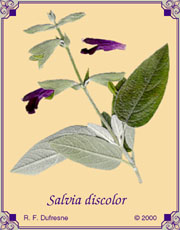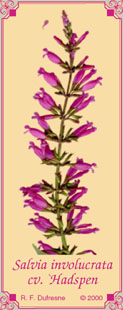Salvia cacaliaefolia
|
![]()
Links to Other World of Salvia Pages:
 |
Guatemalan Blue Vine Sage This sage is found in southern Mexico (Chiapas) and Guatemala in cool mountains and can withstand some freezing. It is a spreader that outgrows other plants in clearings. As a result, it spreads like a tall ground cover when there is no competition. Otherwise, it grows over the tops of other plants, emulating a vine. It is also a good subject for a large hanging basket. It is related to S. patens, and has often been sold as such. However, its bloom lacks the size and huge lower lip of that species. It is also much more durable, withstanding humid subtropical nights. ©2000 by Richard F. Dufresne |
 |
Aromas Blue Ball Sage Blue ball sage gets its name from the blue flowers that come out of the globular clusters of flowers. The true species is greener and smaller with blue instead of lavender flowers. True forms are `Winnifred Gilman’ and `Betsy Clebsch’. This form is probably a hybrid with S. leucophylla like `Alan Chickering’. Other California sages in section Audibertia like S. mellifera and S. sonomensis are possible parents. All of these sages like Mediterranean climates, and can be grown as annuals in the Northeastern and Midwestern states. One of the nicest features of this plant is its pleasantly scented foliage. It can be used for potpourri and at dawn, dusk, and after rains, the whole plant emits its welcome scent to its surroundings. It would fit in nicely near a patio or swimming pool. Camphor is one of its odor components. ©2000 by Richard F. Dufresne |
 |
Andean Silver Leaf Sage A plant for a perennial garden, its brilliant silvery foliage really stands out when it is in bloom. The silvery hairs, normally on the underside of the grey-green foliage, migrates to the floral stems, giving the plant the aspect of a large hoary mountain mint, but with deep purple, almost black flowers that peek out of their calyxes. It is not hardy in North Carolina, and handles humidity pretty well for an Andean plant. Full sun does not harm it. It makes a nice annual otherwise in colder climates. ©2000 by Richard F. Dufresne |
 |
Black & Blue Guarani Sage This form of the best known South American sage has dark, almost black calyxes with darker indigo flowers than the common species. It has the same bloom time as the common form, but has fewer and tougher (woodier) stems, and is a bit slower growing. This implies to me that it is hardier. Hopefully someone in zone 5b will test this out. Like the common variety, it is one of the best hummingbird plants around, since it is in bloom most of the warm months of the year. It also forms tubers and is susceptible to being eaten by pine voles. The way to minimize this problem is to incorporate gravel or small rock into the soil to discourage digging mammals. It spreads by rhizomes, but is not really invasive like S. uliginosa, which can be a modest thug in rich garden soil. Like many sages, it is hardy in Sunbelt states, and can be grown as an annual or container plant elsewhere. ©2000 by Richard F. Dufresne |
 |
Hadspen Roseleaf Sage This variety of roseleaf sage is familiar in Europe, but is new to the United States. Brought in by the staff at Wave Hill, it was distributed with that designation. It has some structural and behavioral differences with its siblings and cousins (S. involucrata and S. puberula): the involucre of bracts is definitely elongated; the flowers persist much longer in the flower stalks; and the branches bend to the ground after a few exposures to wind, resulting in a rambling, bramble-like shrub. It develops into a splendid planting for anyone who has the room for it, and is early to bloom. Naturally, hummingbirds feast on it. I suspect it is of hybrid origin, and would like to get some idea of
its provenance.
©2000 by Richard F. Dufresne |
 |
Big Red Sage (Texas) A species from flood plains of the Edwards plateau of central Texas, this curious species has a very showy display. For some reason, it emulates many tall penstemons with its thick stems and leaves and large flowers. Although it sets ample seed, it does not seem to germinate or root cuttings readily. It has peculiar soil requirements, since its native environment is the caliche (limestone clay) of Texas. Tony Avent at Plant Delights has successfully grown one in Raleigh for at least five years on the scree bank of his roadside garden. Of course, the numerous red-purple flowers attract hummingbirds. If more information can be collected on the culture of this endemic, it holds promise as a nice perennial for places that otherwise may not be able to grow sages well, like the coquina soils of Florida. It was once thought to be nearly extinct some years ago. Since it was rediscovered, other foragers quickly realized that it was more common than once expected. It seems to have no close relatives amongst other native sages. ©2000 by Richard F. Dufresne |
Links to Other World of Salvia Pages:
![]()
|
Salvia cacaliaefolia
|